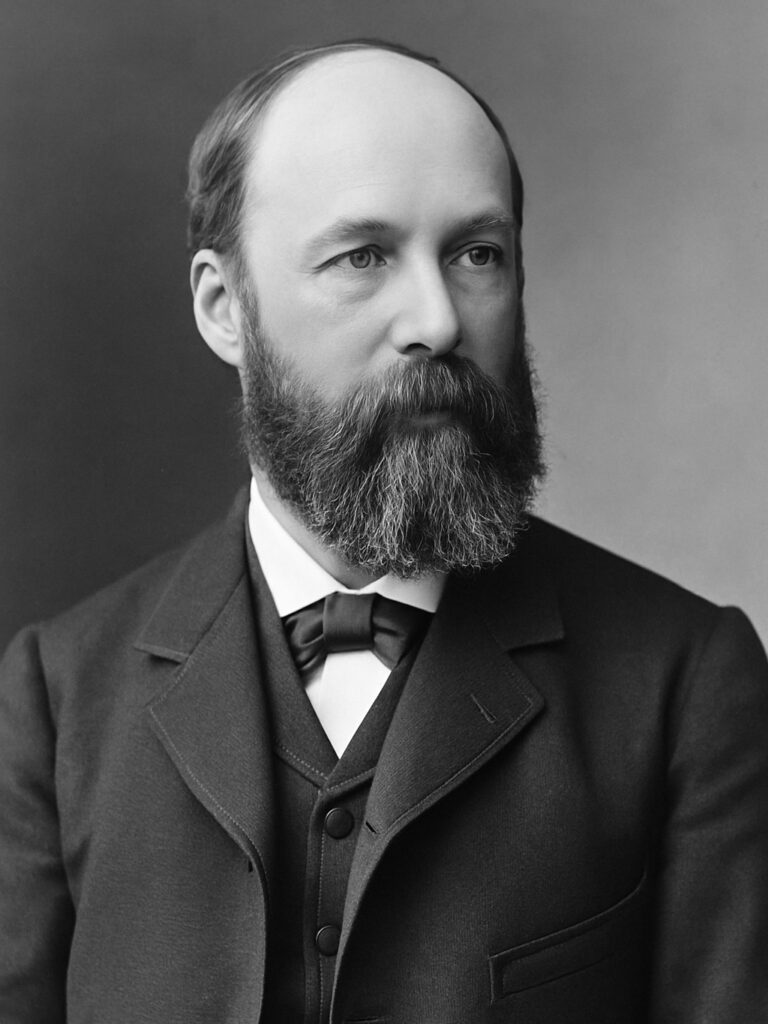Alfred Lewis Galabin

Alfred Lewis Galabin (1843-1913) was an English obstetric physician.
Galabin published 50 papers related to obstetrics and gynaecology but is best remembered for his two textbooks: Diseases of Women, in six editions from 1879 to 1903; and A Manual of Midwifery published in seven editions from 1886 to 1910. The latter was given first place among the treatises on that subject in the list of textbooks for students issued in the Lancet.
Galabin was convinced that obstetrics should be a surgical specialty rather than medical, and his persistence at Guy’s proceeded to the appointment of obstetricians with surgical training; claiming hysterectomies and ovariotomies from general surgeons
Held in high esteem for his practice and publications as an obstetric physician. However his non-eponymised contributions to the field of cardiovascular medicine have faded into almost complete obscurity. Using an apexcardiogram, Galabin was the first person to document atrioventricular (AV) block in humans.
Known for his kind and gentle manner, he enjoyed chess, travel, gardening and botany. Recognized for his first documentation of AV block in humans, alongside his more transcendent contributions to obstetrics and gynaecology
Biography
- Born 10 January 1843, Camberwell
- 1862-1866 Studied Classics and Mathematics, Trinity College Cambridge. Graduated with first class honours in both degrees, receiving the Wrangham gold medal
- 1868 – Fellow of Trinity College. MA (1869)
- 1869-1873 – MB and MD at Guy’s Hospital Medical School
- 1872 – Membership of the Royal College of Surgeons
- 1874 – Despite having initially intended to practice general medicine, he took an immediately available position on the obstetric staff of Guy’s Hospital
- 1874 – Lecturer on clinical midwifery
- 1874 – Membership of the Royal College of Physicians
- 1875 – Obstetric assistant physician
- 1876 – Lecturer on diseases of women
- 1878 – Fellowship of the Royal College of Physicians
- 1876-1880 Editor of the Obstetrical Journal of Great Britain and Ireland
- 1884 – Full obstetric physician, following the retirement of Braxton Hicks
- 1898 – Council of the Royal College of Physicians
- 1899-1890 – President of the Obstetrical Society of London
- Died 25 March 1913 Bishop’s Teignton, Devon
Key Medical Attributions
In 1873, Galabin was the first to demonstrate atrioventricular block in humans. He used the apexcardiogram to study patients with mitral stenosis, and found a patient with a slow pulse – the case report in which he described atrial contraction asynchronous with ventricular contraction.
Richard B-, was a 34 year old male who presented with a pulse of 25-30 bpm. Figure 14 (XIV) demonstrates ‘wavy movements’ in the long diastolic interval and could be attributed to movement artefact. However a repeat study taken later in the same day, figure 15 (XV), demonstrates an almost exact repetition. [1875;20:261–314]
Galabin postulated that the atria of the heart contracted twice in the interval between two ventricular contractions, and sometimes singly in the midst of a long pause instead of just before the systole of the ventricle.
Subsequent analysis of Galabin’s laddergrams insinuate the patient had advanced AV block with 3-to-1 and 2-to-1 AV conduction with Wenckebach periodicity

Controversies
Described as too undemonstrative to be popular with most of the students, and his lectures, despite being meticulously prepared and full of good material, “lost weight by being read without emphasis”
His high mathematical knowledge and subsequent tendency to resort to mathematical proofs in his books did not always appeal to student readers; if only for fear of an expectation for them to recall such proofs when Galabin was an examiner
Notable Quotable
Mr. R. Clement Lucas writes posthumously of Galabin
A true and always loyal friend was Galabin. How well I remember his first arrival at Guy’s Hospital, with his extraordinary reputation as a ‘double first’ from Cambridge, and with what critical eyes we scanned the new recruit to trace wherein his great powers lay. A pale, black-haired, slight, delicate, spectacled man, clearly no athlete, he was probably reared with books as his early companions, at a time when boys are demonstrating their evolution by violent sports.
Major Publications
- Galabin AL. On the connection of Bright’s disease with changes in the vascular system, with illustrations from the sphygmograph. Cambridge Thesis. London. 1873:1–39.
- Galabin AL. On the causes of the secondary waves seen in the sphygmographic tracing of the pulse. J Anat Physiol 1873;8:1–22;112.
- Galabin AL. On the interpretation of cardiographic tracings, and the evidence which they afford as to the causation of the murmurs attendant upon mitral stenosis. Guy’s Hosp Rep 1875;20:261–314.
- Galabin AL. On the state of the circulation in acute diseases. Guy’s Hosp Rep 1874;19:61–100.
- Galabin AL. On the transformations of the pulse-wave in the different arteries of the body. J Anat Physiol 1876;10:297–319.
- Galabin AL. On the causation of the water-hammer pulse, and its transformation in different arteries as illustrated by the graphic method. Med Chir Trans 1876;59:361–388. [Watson Water-Hammer pulse]
- Galabin AL. A manual of midwifery. London: Churchill 1886
- Galabin AL. The Hunterian oration on the etiology of puerperal fever. 1887
- Galabin AL. Diseases of women. London: Churchill 1903
References
Biography
- Obituary: Alfred Lewis Galabin. Br Med J 1913;1:748-750
- Obituary. Alfred Lewis Galabin. Lancet 1913;181(4675):996-997
- Obituary. Alfred Lewis Galabin. J Obst & Gyn Brit Empire 1913;23:310–317
- Biography: Alfred Lewis Galabin. Lives of the Fellows of the Royal College of Physicians of London. Munk’s Roll: Volume IV:256.
Eponymous terms
- Upshaw CB Jr, Silverman ME. Alfred Lewis Galabin and the first human documentation of atrioventricular block. Am J Cardiol. 2001 Sep 1;88(5):547-50
- Cadogan M. History of the Electrocardiogram. LITFL
- Cadogan M. History of Second-degree Atrioventricular block. LITFL
Eponym
the person behind the name
Dr Ben Mackenzie emergency medicine trainee | LinkedIn |
